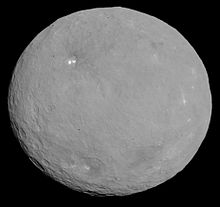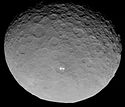
Ceres Polar Lander (CPL) is a European mission concept for a lander to Ceres that would search for biosignatures.[1] Published in 2008, the concept calls for a low-cost mission using reliable existing technology to complement other larger missions.[2] The original concept of the mission was to search for water ice and signs of life in permanently shadowed craters near Ceres' north pole.[2] However, with new information from the Dawn mission, it is now thought that water ice can be found on other locations on Ceres and that Occator crater may be a more desirable scientific target.[3]
If funded and launched, it would take about four years to reach Ceres, assuming a launch by a Soyuz rocket.[1]
References
[edit]- ^ a b Pullen, Lee (16 April 2009). "New Lander Could Probe Dwarf Planet Ceres For Life". Space.com. Retrieved 12 March 2019.
- ^ a b Poncy, J; Grasset, Oliver; Martinot, V; Gabriel, Gabriel (September 2008). "Preliminary assessment of a Ceres Polar Lander mission". European Planetary Science Congress: 403. Bibcode:2008epsc.conf..403P.
- ^ Weitering, Hanneke (5 November 2018). "Now That Dawn Is History, Should NASA Send Another Mission to Ceres?". Space.com. Retrieved 14 March 2019.


Well, that’s interesting to know that Psilotum nudum are known as whisk ferns. Psilotum nudum is the commoner species of the two. While the P. flaccidum is a rare species and is found in the tropical islands. Both the species are usually epiphytic in habit and grow upon tree ferns. These species may also be terrestrial and grow in humus or in the crevices of the rocks.
View the detailed Guide of Psilotum nudum: Detailed Study Of Psilotum Nudum (Whisk Fern), Classification, Anatomy, Reproduction